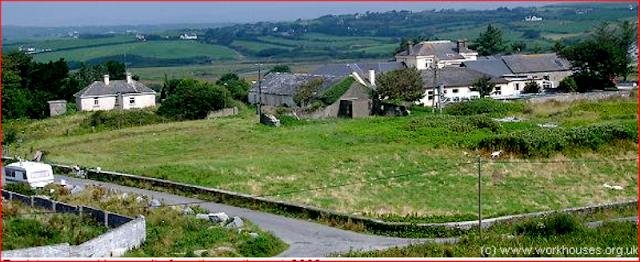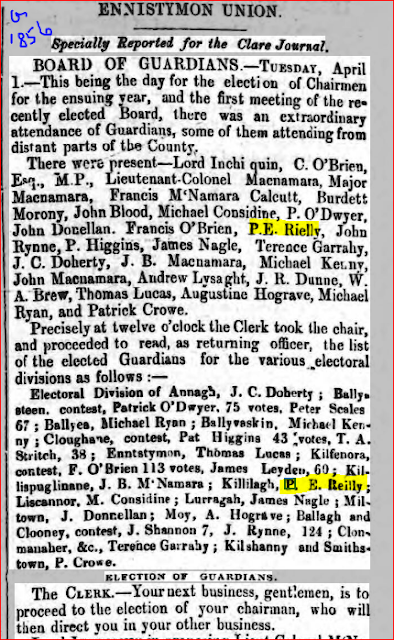In a letter written to her brother in 1955, Gladys Galwey-Foley mentions that the Foleys came to Ireland with the Plantagenets.
Although I have yet to uncover the Foley-Plantagenet connection, the Milward branch of our Family Tree overflows with many interesting historical figures.
Today's post features one of those illustrious ancestors - our 15th great grandfather, Sir James Tyrrell.
Doesn't everyone love a mystery?
One mystery that has captivated the imagination of historians for almost 600 years is the "Murder of the Two Princes in the Tower".
At the time of King Edward IV's death, these two young boys were his only surviving sons. Before he had died in April 1483, the King had placed them under the protection of his brother, Richard, the Duke of Gloucester.
While preparations for the older son's coronation were underway, their Uncle Richard had both boys lodged in the Tower of London - for their protection.
However, while imprisoned in the Tower, Richard Duke of Gloucester usurped the Throne for himself ....
And the princes disappeared.
It has always been assumed that the Princes had been murdered...... But, by whom?
During the reign of King Henry VI, our 16th great grandfather, Sir William Tyrrel (1415-1462) was the Sheriff of Norfolk and of Suffolk.
But, in 1462, an alleged plot to murder King Edward IV had been discovered and Sir William was named as one of the conspirators.
Unfortunately, since no trial records have survived, his role in the plot has never been made clear.
Our 16th great grandfather was beheaded for treason on Tower Hill on February 23, 1462 and was buried in London at the Austin Friars Churchyard.
Sir William's execution left a 37 year old widow, Eleanor Margaret Darcy and, at least, four daughters and two sons - one of whom was our 15th great grandfather.
James Tyrrell (1450-1502) was only 11 years old when his father was executed and little is known about his early life but in 1469, he married an heiress from Cornwall named Anne Arundell (1445-1483)
Sir James first became noteworthy in 1471 when he was knighted by King Edward IV on the Battlefield at Tewkesbury.
Shortly afterwards, in 1473, he was entrusted with escorting the newly widowed, Anne de Beauchamp Countess of Warwick, to the Sanctuary at Beaulieu Abbey.
Because Beaulieu Abbey was the only abbey in the region with very strongly enforced sanctuary rights, the Countess was assured of her safety.
As such a secure sanctuary, Beaulieu Abbey became a recourse of fugitives, ordinary criminals, debtors and political enemies of the government.
And among these latter was Lady Anne de Beauchamp, whose deceased husband - Warwick the King-maker - had been killed during the battle of Barnet.
With her husband and children all dead and having been denied the restoration of her estate, The Countess spent the rest of her life in the lonely safety of Beaulieu Abbey.
She died in obscurity at the Abbey in 1492.
In 1475, while in the retinue of the Duke of Gloucester, Sir James was with the King's Army during the abortive war in France.
James' star continued to rise with Appointments as Commissioner in Suffolk in 1475; Sheriff of Glamorgan in 1477 and Member of Parliament for Cornwall in 1478. (By this time, he was only 28.)
In a letter to his cousin, Sir William Stoner, Sir James claimed to have persuaded his Lord of Gloucester to excuse Stoner's brother for some unnamed fault.
Evidently, the Duke (Richard) thought well enough of Tyrrel to grant this personal favor.
Sir James is listed among the Knights at the coronation of Gloucester as King Richard III in 1483 and he was made Master of the Horses AND Master of the King's Henchmen.
(The Master of the King's Henchmen was responsible for training and educating squires of the King.)
That same year, he was made Commissioner of Array for Wales and was appointed Steward of Cornwall for life.
In February 1484, Sir James Tyrrel was granted stewardship of Buelt in Wales for life.
Six months later, he was made a Chamberlain of the Exchequer (Treasury).
He was in France in 1485, so played no part in the Battle of Bosworth which signalled the end of the Yorkists and the start of the Tudor dynasty - King Henry VII.
In the following year, King Henry VII appointed him Governor of Guînes (the English possession of Calais).
Sir Tyrrell fought at the Battle of Dixmunde in 1489 and, as Captain of Guînes, took part in the negotiations leading to the Peace of Ėtaples in June 1492.
Sir James competed in the Tournament celebrating the creation of Prince Henry as Duke of York in 1494 and participated in the festivities marking the arrival of Katherine of Aragon in 1501.
In short, Sir James Tyrrell had become an accepted and respected figure in the Tudor administration.
Sir James Tyrrell was now a man of influence and power.
However, in early 1501, Tyrrell was found to have lent his support and refuge to the leading Yorkist claimant to the English throne - Edmund de la Pole.
By spring, Henry VII had him arrested in Guînes Castle and returned to London.
Under torture, Tyrrell is said to have confessed to the murder of the two Princes but a written confession has never been found.
After a very speedy trial at Guildhall, he was charged with treason and sentenced to death by decapitation.
For treason, King Henry VII could have had him hanged, drawn and quartered, so this sentence of beheading was lenient for the times.
On May 6, 1505, Sir James Tyrrell was beheaded on Tower Hill at the Tower of London.
His body was taken from Tower Hill and interred in the Churchyard of the Austin Friars - which is also his father's final resting place.
King Henry VII had Sir James Tyrrell executed for treason but failed to mention the murders of the two royal princes and his confession has never been found.
Although maligned for centuries as a treacherous murderer of the worst kind, there is no real evidence to support a confession by Sir James Tyrrell.
So - what could have happened to the two young Princes?
A Tyrrell family tradition passed down through the generations claims that "...the princes and their mother, Elizabeth Woodville, lived in the Hall by permission of the uncle....."
The "Hall" could be Tyrrell's home - Gipping Hall. The "uncle" would be Richard III.
So, the Tyrrell family believes that, instead of murdering the princes, Sir James hid them and their mother in his home where they would be safe. They were smuggled to France at some later date.
At the time of his execution, in Sir James' possession was a document detailing the entire episode. When James refused to turn it over to Henry, the King had him beheaded.
One of the many theories in consideration about this mystery -
"In1485, Richard III gave a Charter to Llandovery, and appointed James Tyrell to be steward of Llandovery Castle. Before Bosworth he sent Tyrell to France to ‘monitor’ the build-up of the ‘invasion’ expected from Henry. Were the princes housed at that time in Llandovery Castle, or did Tyrell take them out of England into France for their safety? If we believe Tyrell to be the murderer of the princes, maybe we should start by digging up the car-park beside Llandovery Castle, to see what we may find."
”http://www.llandoverytheatre.com/richard-111
We might never know the truth.
There you have it - Sir William Tyrrell, executed for treason in 1462, was our 16th Great Grandfather and his son, Sir James Tyrrell, also executed for treason in 1502, was our 15th Great Grandfather.
Here is the genealogical line-up:
16th Grandfather: Sir William Tyrrell (1415-1462)
Sir James Tyrrell (1450-1502)
Lady Anne Tyrrell (1479-1534)
Lord Thomas Wentworth (1500-1551)
Lady Anne Wentworth (1520-1575)
Lady Susanna Poley (1539-1604)
Captain Francis Crofts of Landford (1567-1638)
William Crofts (1606-1663)
George Crofts, Esq, of Churchtown (1642-1698)
Judith Crofts (-1739)
John Freeman, Esq, of Ballinguile (1678-1741)
John Freeman, Esq, of Cahirmee (1713-1776)
Eleanor Freeman (1753- )
John William Henry Milward, Esq (1869-1882)
John Harnett Milward, Esq (1817-1870)
Mary Frances Julia Milward (1855-1904)
Patrick Henry Reilly (1886-1960)
Henry James Joseph Reilly (1922-1999)
Susan Reilly (1950- )
Reilly James Ignatius DeVore (1977- )
Freya Vitina DeVore (2014- )
We hope you have enjoyed learning more about our 16th and 15th great grandfathers.
We consulted many websites in our research and, to them, I offer my gratitude:
http://www.holbeinartworks.org/efaqssevenhsirjamtyrfifteen.htmg
https://murreyandblue.wordpress.com/tag/sir-james-tyrrell/
http://www.kateemersonhistoricals.com/TudorWomenA.htm
http://www.oxford-shakespeare.com/Probate/PROB_11-17-263.pdf
http://www.shakespeareandhistory.com/james-tyrrell.php
http://home.cogeco.ca/~richardiii/tyrell.html
EPILOGUE
History gives a nation its bearing on what it is and how its people are affected by what has happened in the past.
Its kings and queens, its wars - with victories and defeats - these all mold a nation’s culture into the way it views itself in the present.
In the same way, a family history presents how a family has survived and come to terms with the great social and cultural experiences of the ages.
We hope these stories will give each member of our family a foundation and, in some small way, explain how we came to be what we are today.
Hopefully, through these vignettes, our future generations will gain a knowledge of the energy and dynamism, the loves and hates, the errors and mistakes, the victories and failures, the struggles and successes that make us what we are.
Our family history presents a fascinating read - and, hopefully, some lessons to be learned in the process.














































